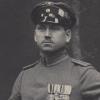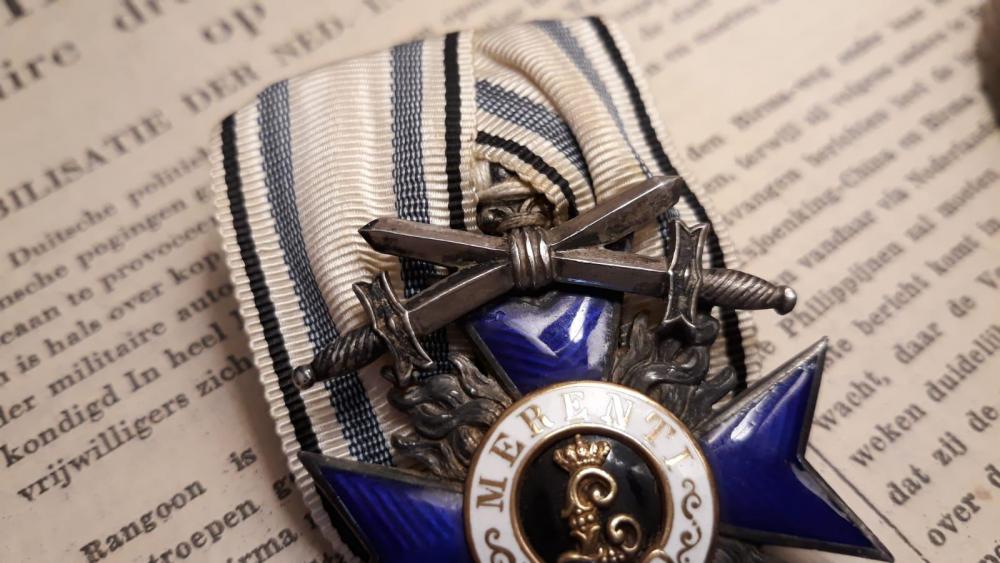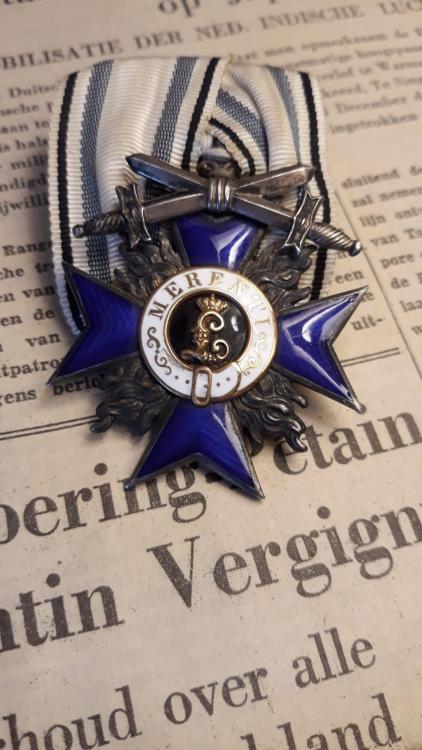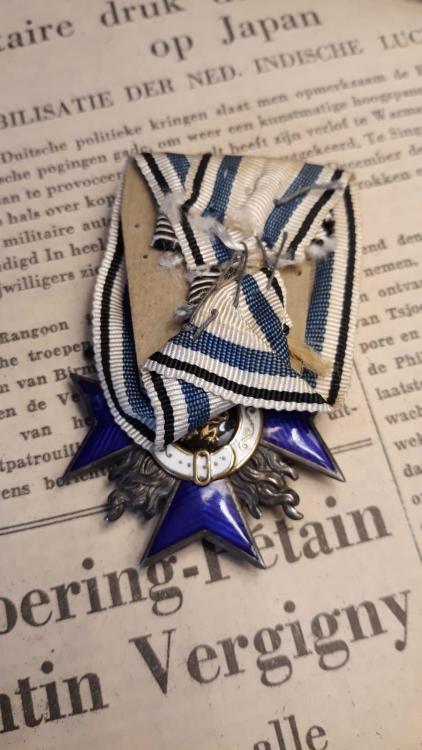-
Posts
487 -
Joined
-
Last visited
-
Days Won
2
Content Type
Profiles
Forums
Blogs
Gallery
Events
Store
Posts posted by spolei
-
-
It ist a Leser, the last type with silver guilt medaillons, given from 1917 till the end of war.
0 -
The amount of the award was based on the position and not on the rank. For example Company commander, regimental leader, battalion commander, etc. The fourth class was the most widespread and was lent from the first officer grade. If the MVO was awarded the same rank a second time, it would be the next higher class , or the officer got a higher position in the army. The silver guilt MVO were given since 1917. To save resources, there was an order that no real gold awards may be awarded.
1 -
-
2 hours ago, FAR 32 said:
Hello,
I would like to correct the above observation regarding the Austrian war ribbon, or Bravery Medal Ribbon as it is better known among Austrians. There is much confusion about Austrian devices for this ribbon, but a staff member at Dorotheum clarified things for me.
It is true that both NCO/EM's and officers wore this ribbon, but only officers' ribbons had crossed-swords devices. Such crossed-swords devices on a ribbon bar could represent the Military Merit Cross with War Decoration 3rd Class or the Signum Laudis or the Franz Josef Order Knights Cross. (Sometimes a golden wreath device was used to represent the Military Merit Cross 3rd Class with War Decoration when available, but these wreaths were not always available, so swords were used instead.)
A device with both a gold crown and gold crossed-swords represents the Gold Merit Cross with Crown with a crossed-swords-device on the Bravery Medal Ribbon (Goldenes Verdienstkreuz mit der Krone am Tapferkeits-Band mit Schwertern am Band.)
The presence of this device alone on the Austrian ribbon tells me that the bar's owner was an officer. That means the silver devices on the Bavarian ribbons represent the MVO4X with and without crown, respectively.
Thanks for the detailed explanation about the Austrian ribbons. Unfortunately, you can not find the class of the MVO over the color of the swords. These may also be third classes of the MVO. From what rank was the Iron Crown awarded?
0 -
I see here rather the ribbon for the order of the Iron Crown Austria, not for the swedish order. As a noncombattant award should the swedish order on the last position. The crown swords edition on the Austrian bravery ribbon disturbs me. The Order of Military Merit had an oak leaves wreath on the field clasp, Signum Laudis had swords, the medals for bravery also had no crown as a support. Finding out a name becomes difficult.
0 -
1 hour ago, laurentius said:
Dear Spolei,
thanks for your reply. I fear I won' t be able to show you the back of the agraffe, since the order is sown down tightly. You say that the swords are early Hemmerle. Would I be correct in saying the entire cross is early (pre-1916)?
Kind regards, and thanks in advance, Laurentius
Hello Laurentius,
there is no sign for silver guilt. This will be real golden medaillons. The satincolour of the lion and the "L" could be patina.
The medaillons of my cross are older, they differ a little bit to yours.0 -
On 02/10/2019 at 19:10, laurentius said:
Dear fellow collectors,
I was finally able to add a nice BMVO4x to my collection. It has sadly been removed from the original medalbar, a naughty Bavarian bar I think, given the folding and the damage to the back of the left arm. I know it was made after 1916, but would any of the more knowledgable collectors be able to help me to determine the maker?
Kind regards, and thanks in advance, Laurentius
Very nice Hemmerle MVO.
The swords are early production. In my collection is also a early Hemmerle marked 980 with this kind of swords.
Can you see the backside of the agraffe, what is it's marking?
0 -
-
Hello, I'm trying to explain the individual stages of the MVO with a translator
Until 1905 there were 5 classes of the MVO.
Grand Cross + Star
Grand Commander + Star
Commander + Star
Knight 1
Knight 2
The knight crosses were made of gold, the first class was with flames, the second class without flames.
In 1900, the officer's cross was also introduced
that was placed between Commander and Knight 1.
NCO`s and soldiers got the Military Merit Cross, same size as the Ritter 1 but made of silver, only one class.
In 1891 Prince Regent Luitpold donated the swords for combattants.
War veterans ( 1866 and 1870/71) were allowed to retrofit the swords their awards at their own expense.
The colonial awardings were then awarded with swords.
In 1905 the classes were switched to
Grand Cross + star
1st class (previously Grand Commander) + star
2nd class (previously Commander) + star
officer's cross
3rd class (previously Knight 1)
4th grade (previously Knight 2)
In addition, the crown was added to the individual classes.
The Military Merit Cross got 2 classes.
From 1913 till 1918
The military merit cross was changed in first, second and third class in addition the crown, so that we had 6 classes.
The MVO was not increased further
Regards Andreas3 hours ago, filfoster said:The medal just visible beneath this one looks like a knight's cross for the Max Joseph Order.
He got the MMJO in the 1870 war, in WW1 the Grandcross of the MMJO
0 -
Hello,
that's no BMVO third class swords, it is a Ritter 1 with swords. He got his decorations in the 1866 and 1870 campaigns.
He was reactivated in 1914 as a general, so he would be awarded with the highest class of orders.0 -
2 hours ago, VtwinVince said:
There was, I believe, only one manufacturer of the third class, and the flames were separately attached.
There are third classes of Hemmerle and Leser, two manufacturer.
Weiss has not delivered any third classes to the bavarian "Ordenskanzlei".2 hours ago, graham said:laurentius,
I hope this what you are looking for, I have circled a few of the areas of interest:
This is what I first thought to be a 'BMVO3X'!!! but as you can see it is actually is a BMVO4X that has been gold plated. The flames are cast as part of the Order.
This is a BVMO3X which has gaps between the cross arms and the flames:
https://woeschler-orden.de/node/4000
VtwinVince,
I have seen both Jakob Leser and Gebrüder Hemmerle BVMO3X's. Not sure if there were any other manufacturers.
Thats right and the weight of the 3. class is lighter. Thats a often seen fake. For a counterfeiter an easy game with a high profit.
0 -
-
Hello,
the first class is a cross of the manufacturer Weiss&Co, the swords are from Leser. This cross is a bad fake., originally a third class.
The MVO is a Hemmerle. The backside medaillon seems new enameled. Normaly the lion had to be seperate and not in the enamel. I think this is a recycled MVO.0 -
-
That's right. These crosses were made for the production of medal bars. In this case from the manufacturer Godet. They were not awardet. The price is equal as the lent.
0 -
Very nice Hemmerle, production 1914/1915. he third class is the latest version of Leser.
0 -
-
Manufacturer was Deschler.
Swords without the "D" marking, but it doesn't matter. Not all Deschler-swords were marked.0 -
Nice Hemmerle 2nd class with markings GH on the agraffe and on the swords. On the swords the 900 was ground, since they are silvered from non-ferrous metal and not from real silver.
0 -
Sorry, but that's a fake. The cross is from the manufacturer Weiss, the swords from Leser.
Weiss didn't produce this class. This would be a third class new enameled and guilt.0 -
You are right. 75 medals were made of gold, 11 medals were produced in silver guilt.
The medal was awarded by Prinzregent luitpold on the occasion of the 50th anniversary of his membership in the Order of Saint George on 15th dec 1889. Only the members, who take part at this jubilee, were be awarded.0 -
The awarded medals were made of gold, not silver guilt. It is a very rare medal and the most offers are copys.
0 -
-
19 hours ago, Utgardloki said:
Interresting that he decided to sew his medals on a ribbon bar... or was this done later by another person?
I think it was done from the owner after WW2.
There are the third Reich medals missing like the airforce servicemedals, hungary warmedal and Sudetenland Anschlussmedaille.
There is no ribbon of the KVK II. In WWII the owner wears the ribbon of the KVK in the buttonhole and the ribbon bar in this way.
After the war he sew his decorations on the ribbonbar for veterans meetings.0








What do you know about Bavarian MVOs and MVKs
in Germany: Imperial: The Orders, Decorations and Medals of The Imperial German States
Posted · Edited by spolei
Hello,
look here this third class.
https://woeschler-orden.de/node/2834
In the third class, there must be a narrow gap between the cross arms and the flames.
The third grade is lighter because the flames are hollow. In the fourth grade, the cross body with the flames is of one piece.